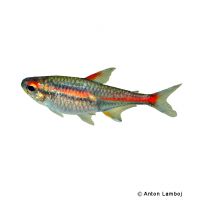Glowlight Tetra (Hemigrammus erythrozonus)
| Glowlight Tetra Hemigrammus erythrozonus | |
|---|---|
| Name | Glowlight Tetra |
| Name Lat. | Hemigrammus erythrozonus |
| Family | Characins |
| Family lat. | Characidae |
| Order | Characins |
| Order lat. | Characiformes |
| Origin | South America |
| Habitat | Tributaries, forest streams |
| Diet | Omnivore |
| pH | 5.0-8.0 |
| Behavior | Peaceful |
| Keeping | Group |
| Care Level | Moderate |
| Reproduction | Egg scatterer |
| Breeding | Moderately difficult |
| Life Span | 3-5 years |
| Protection | No |
| Metric Units | |
| Size | 4 cm |
| Temperature | 23-29 °C |
| Hardness | 5-15 °dH |
| Aquarium | 60 cm / 54 l |
| US Units | |
| Size | 1.6" |
| Temperature | 73-84 °F |
| Hardness | 89-267 ppm |
| Aquarium | 15 gal |
Distribution and habitat
The glow tetras originate from the tributaries of the Essequibo River in Guyana. There they live in the slow-flowing, nutrient-poor blackwater rivers that originate in the humic rainforests and are dark brown in color.
Maintenance
The aquarium should have soft, slightly acidic water and varied planting that provides both shelter and swimming space. A dark substrate, shaded light (floating plant cover) and low current is ideal.
There should be no detectable ammonia, ammonium or nitrite, and the nitrate level should not exceed 100 mg/l. To ensure the water quality and oxygen content, a filter and heater adapted to the aquarium size is required, as well as lighting for the species-appropriate day-night rhythm of the animals.
Diet
The food offer consists of live food, such as cyclops, daphnia and tubifex, which is accepted without problems also in frozen form, supplemented with frozen food mixtures. Especially mysis and mosquito larvae should not be missing. In addition, they also need some vegetable food, such as crushed peas, mashed leafy and wild vegetables or dry food (flakes, granules) with high vegetable content (spirulina, kelp)
A regular and varied diet promotes health and increases resistance. Only feed as much as is eaten immediately (in a maximum of 10 minutes).
Behaviour and compatibility
Glowlight tetras are peaceful, well-tolerated schooling fish suitable for any community tank. At least 5, but preferably considerably more Glowlamp Tetras should be kept together.
Basically, only mutually compatible fish species with similar demands on water conditions and water temperature should be socialized
Sex dimorphism
Females have a distinctly rounded abdomen and are stronger and larger than the slender males
Reproduction and breeding
In soft, slightly acidic peat water they usually spawn up to 300 eggs between fine-feathered plants. The larvae hatch after about 24 hours and swim freely from the 5th day.
Fry must be fed several times a day with special rearing food (dust food). In community tanks breeding is hardly possible, because the spawn is easy prey.
Important
Feeding plant foods reduces the risk of fish eating the tender shoots of aquatic plants.
The well-being of the fish should be checked regularly. Temperature should be checked daily, pH, hardness and nitrate levels should be checked at least every 14 days. Regular partial water changes are recommended, even if the contaminant level has not yet reached the upper limit. Sudden changes in water quality should be avoided. Newly introduced fish must be accustomed slowly to the water in the aquarium.
Further literature can be found in your pet store.
References
Text: Sabina Lamboj; Image: Anton Lamboj
Source: BMELV (1998): Tierschutzgutachten - Haltung von Zierfischen (Süßwasser); RIEHL & BAENSCH (2006): Aquarien Atlas Bd. 1, Mergus Verlag; ENGELMANN (2005): Zootierhaltung - Tiere in menschlicher Obhut: Fische, Verlag Harri Deutsch
- Gemäß § 21 Abs. 5 Tierschutzgesetz idgF
